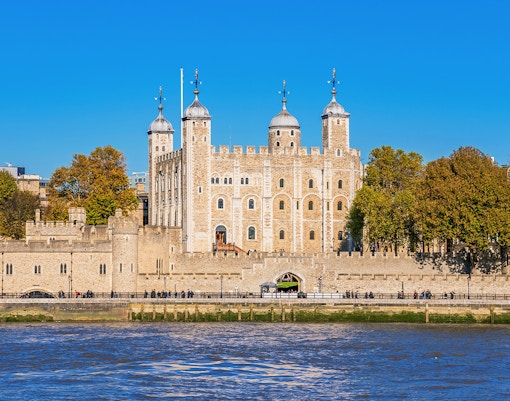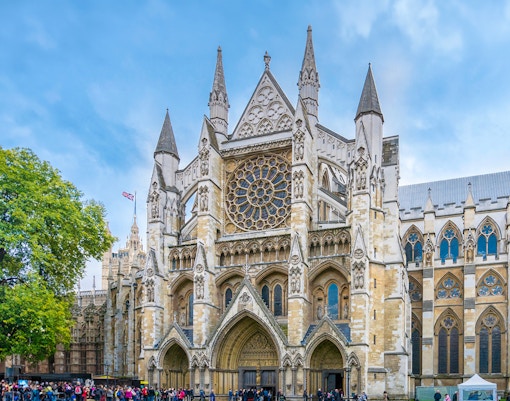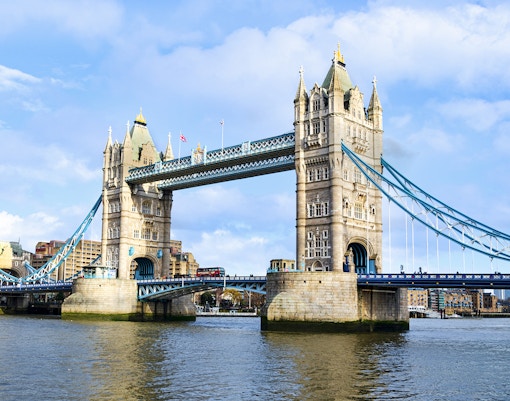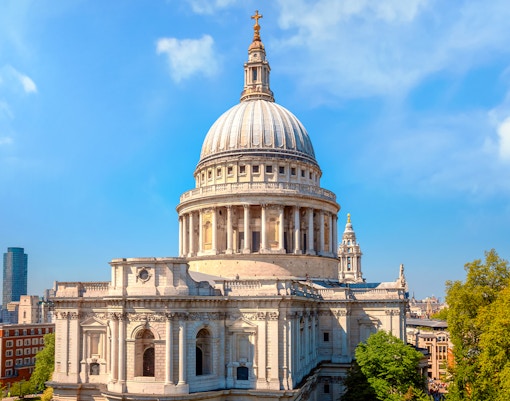- London Theatre Tickets
- London Eye
- Harry Potter London Tours
- Tower of London
- Madame Tussauds London
- SEA LIFE London Aquarium
- The Shard
- London Dungeon
- Westminster Abbey
- Frameless London
- Tower Bridge
- London To Stonehenge Tours
- London To Windsor Castle Tours
- Up At The O2 Climb
- Buckingham Palace
- Heathrow Airport transfers
- St. Paul's Cathedral
- London City Passes
- National Express London
- Kew Gardens
London Travel Guide | Top Attractions, Travel Essentials, Tips & More
Top 10 things to do in London
London Travel Essentials

Travel essentials in London
- Time zone: Greenwich Mean Time (GMT)
- Language: English
- Socket type: Type G
- Currency: Great British Pound | GBP | £
- Country code: + 44
- Emergency numbers: 999 (for any kind of emergency), 111 (specifically for medical purposes) and 112 (if you need help from a coastguard)

High season
When: April to August
What to expect:
- Museums, monuments, and other tourist destinations will likely have long queues.
- Expect maximum flight rates and high hotel occupancy during the High Season.
Which attractions have high visitors during peak months: London Eye, Tower of London, and British Museum
Which attractions offer a relaxed experience during high season: The Geffrye Museum, Wilton's Music Hall, and The Museum of London Docklands
Events during high season: Wimbledon, London Pride, and Notting Hill Carnival

Shoulder season
When: March, April, September, and October
What to expect:
- The best times to visit are in the spring and fall when the weather is pleasant and crowds are minimal.
- Hotel and restaurant prices are high but more easily acquired during the shoulder season.
Which attractions have high visitors during shoulder season: Kew Gardens, Hyde Park, and Tower of London
Which attractions offer a relaxed experience during shoulder season: The London Canal Museum and The Royal Observatory Greenwich
Events during shoulder season: London Marathon, Halloween celebrations, and Totally Thames festival

Low season
When: November to February
What to expect:
- In general, the weather is cold and damp.
- If you don't mind the rain, you will be rewarded with fewer crowds of people and queues at top tourist attractions.
- Off-season tourists will find great deals on airfare and hotels.
Which attractions have high visitors during low season: London Dungeon, West End Theatres, and London Eye
Which attractions offer a relaxed experience during low season: Thames River Cruise, Kew Gardens, and Little Venice
Events during the low season: Winter Wonderland in Hyde Park and Christmas markets

For Spring and Autumn:
- Lightweight clothing such as blouses, shirts, light sweaters, trench coat, waterproof jackets and scarves
- Comfortable and waterproof boots and shoes
- Compact umbrella, in case of unpredictable weather changes
- Lightweight gloves for chilly mornings
For Summer:
- Breathable cotton or linen tops, tank tops, t-shirts and blouses, along with shorts, skirts and dresses
- Sunglasses and sun hate to combat the bright sunshine
- Slides or flip-flops for beach days
- Sunscreen to protect yourself from UV-rays
For Winter:
- Insulated and waterproof coats and jackets, scarves, and gloves
- Any other thermal clothing like turtleneck sweaters and woolen dresses would also be great
- Waterproof and insulated boots and shoes
- Umbrella for unexpected rains
General must-haves:
- Reusable water bottle
- Travel adapter
- Portable charger
- Daypacks to carry your belongings during outings

Per person average daily budget
- Budget travel: £45-£60
Budget travelers have reported spending around £60 per day in London. You would have to spend around £20 on meals and £2-£8 on local transportation for a day. Accommodations can cost around £23-£33.
- Mid-range travel: £110-£125
Regular travelers spend around £105 each day. Food would cost around £25 for a day and £10-£14 to get around the city. In addition, the average price for a hotel stay in London is £75+.
- Luxury travel: £450+
Luxury tourists may spend as much as £100+ per day on meals and £50-£100 on transportation, with accommodation coming up to £300+.

Average daily budget for a couple
- Budget travel: £120-£190
The total cost for a couple's spending per day would be around £120-£190. Accommodation would cost around £66-£150, while food would cost around £62-£90. To get around the city, you must shell out £8-£16.
- Mid-range travel: £210-300
The daily cost for a couple who wants a decent mid-budget travel experience would be £210-£300. Food would cost £70-£100, and transportation would be around £10-£20. In addition, the average price for a hotel stay in London is £150-£250.
- Luxury travel: £500+
Couples may spend as much as £200 per day on meals and £50+ on transportation, with accommodation costing £300-£400+.

Average daily budget for a family of 4
- Budget travel: £240-£380
If you are visiting London with your family, you would need to spend at least £240 per day on a budget. Accommodation would cost you nearly £100-£150, while food would be around £80-£120. You would have to spend £16-£32 on public transportation.
- Mid-range travel: £400-600
A three-star hotel for a family would cost £200-£300, and food would cost somewhere around £100-£150. Transportation, including bus fares and tube, would cost anywhere between £20-£40
- Luxury travel: £650-£900+
A family of 4 may spend as much as £200-£400 per day on meals and £50-£100+ on transportation, with accommodation costing £400+.

- Save on sightseeing with the London Pass: This cost-effective option allows you to visit London's top landmarks without breaking the bank.
- Choose public transport: London boasts an extensive public transport network. The Tube often provides the most efficient means of travel, while buses offer a scenic alternative.
- Simplify your travel with the Oyster Card: When loaded with money, this convenient card offers significant savings on public transport compared to paper tickets.
- Optimize your journey by choosing the right airport: Select the one closest to your accommodation to minimize travel time and costs.
- Opt for accommodation in Central London: Central London is close to some major city attractions, so choose your lodging there to reduce travel time.
- Go on a cruise: Consider a boat ride on the Thames for a unique city perspective.
- Explore local food markets: Make a quick stop at markets such as Borough Market for affordable and delectable meals.
- Visit free attractions: Take advantage of London's numerous no-cost museums and galleries, such as the British Museum and the National Gallery.
- Bring a portable charger: Given the extensive sightseeing, your phone battery may deplete rapidly. A portable charger can be invaluable.
- Exercise caution regarding pickpockets: Ensure your belongings are secure and remain vigilant, particularly in crowded areas.

Even though London is generally an expensive city to visit due to its popularity and ample supply of sights, the British capital still has many free things to do scattered throughout. Here are some places you can visit for no cost:
- Visit the British Museum: Discover one of the world's largest and most comprehensive museums, housing the Rosetta Stone and numerous other ancient artifacts.
- Stroll through Hyde Park: This 350-acre scenic green space is ideal for jogging, cycling, or leisurely relaxation. On a warm afternoon, go on a family picnic!
- Check out Shoreditch's street art: The vibrant murals and graffiti in this dynamic East London neighborhood are worth visiting.
- Attend a concert at the Southbank Centre: Enjoy performances by accomplished musicians at the Royal Festival Hall and Queen Elizabeth Hall.
- Experience a serene service at St Paul's Cathedral: Join the daily Choral Evensong to appreciate the cathedral's remarkable acoustics.

Transportation apps:
- CityMapper
- The London Pass App
- Tube Map App
- Free Now
Food apps:
- Deliveroo
- Quiqup
- Hungryhouse
Other useful apps:
- BBC iPlayer
- MeetUp
Know before you visit London

- London City Airport (LCY)
Address: Hartmann Rd, London E16 2PX, United Kingdom - Heathrow Airport (LHR)
Address: Longford TW6, United Kingdom - Gatwick Airport (LGW)
Address: Horley, Gatwick RH6 0NP, United Kingdom - London Luton Airport (LTN)
Address: Airport Way, Luton LU2 9LY, United Kingdom - London Stansted Airport (STN)
Address: Bassingbourn Rd, Stansted CM24 1QW, United Kingdom - London Southend Airport (SEN)
Address: Eastwoodbury Cres, Southend-on-Sea SS2 6YF, United Kingdom

The relevant UK officials make a choice on your visa application, which is primarily based on the required UK visa documents. There are specific documents required for each UK visa. You must gather all of these documents depending on the type of visa you are applying for.
- A valid passport or travel document that contains at least two blank pages and has 6 months of validity from the date of your departure from the UK.
- A filled visa application form and two passport photographs.
- A financial document demonstrating your ability to support yourself throughout your trip. Common documents include proof of income, bank statements, pay slips, and evidence of accommodation.
- A travel timetable for all of your trips, including dates and flight numbers.
- It is also highly recommended to get your admission to the city covered by travel insurance.

If you plan to travel internationally, purchase relevant travel insurance before departing. If you already have travel insurance, check to see what coverage you have for coronavirus-related events, such as medical treatment and travel interruption, and any planned activities, such as adventure sports. If you're keen on purchasing a new policy, look into how it addresses these issues.
- Examine your policy to see if it covers medical expenses.
- Make sure to read the terms and conditions of your policy carefully.
- Select a policy that covers both cargo and personal property loss.
- Procure the plan as soon as possible, preferably before your trip.
- Consider getting an insurance plan that covers 24/7 emergency assistance, which can be invaluable during your trip.
- Check if your pre-existing medical conditions are covered in your policy.
- Understand the claim process, including how to file the claim and the necessary documents to do so.

O2 offers free Wi-Fi at several locations in London, even if you are not an O2 subscriber. Each Wi-Fi session at Starbucks lasts 2 hours, but you can have an unrestricted number of sessions per day if you reconnect after 2 hours. Besides O2 and Starbucks, numerous public libraries, shopping centers, chain restaurants, transport hubs, and select Tube stations also offer free Wi-Fi.
Some of the best internet service providers in London are:

You would need a 900 MHz and 1800 MHz band phone, as well as the ability to use 3G, for your mobile phone to work in the UK. However, be wary of roaming charges, which can quickly add up if you're not connected to the internet. Here's other important information you need to make phone calls in the city:
- Incoming: In order to dial a number in London from abroad, type in your country-specific exit or access code, followed by 44, which is the country code for the UK, followed by the phone number.
- Outgoing: To dial a number outside of the UK from London, type in 00, which is the UK’s international call access code, followed by the country code of the place you are going to call, followed by the phone number.

Drink plenty of water, juice, and other liquids to stay hydrated. Another thing you can do is stay out of the sun as much as possible. On clear days, the sun can be pretty powerful in London, and it is easy to get badly burned. Wear sunscreen if you are outside in the sun. Here are a few other tips for staying healthy while visiting London:
- Avoid eating on the street unless it's a reputed street vendor.
- Make sure to get enough sleep.
- Put on sunscreen and sunglasses.
- Make sure to wash your hands frequently, especially after being on public transportation.
- Eat a balanced diet, including tons of fruits, whole grains, and vegetables.
- Bring all your necessary medications in their original containers in case you require them.

Currency: Great British Pound Sterling | GBP | £
Credit cards are widely used for payment in London. There are numerous ATMs throughout the city where you can withdraw cash. Keep an eye out for ATMs that seem to have been tinkered with. To avoid being charged an exorbitant fee, make sure to ask about service fees and exchange rates before changing money. In London, the following online payment methods are accepted:
- Amazon Pay
- Apple Pay
- Google Pay
- Samsung Pay

In general, London is safe. However, any location with a high number of tourists that is outside of your jurisdiction should be handled with caution. Here are some safety tips for your trip to London:
- Pickpockets can be found in heavily populated regions and on public transportation.
- Take only what you need, leaving your personal items and extra cash at the hotel and only carrying the money you need in a fanny pack hidden away on your person.
- If you plan to travel with extra funds and personal documents, use a pouch or bag with zips and a safe handle or a money belt.
- Stay vigilant on the streets, especially if you come from a country that drives on the right, unlike the United Kingdom.

It's important to note that there are no specific laws or rules implemented to govern a tourist's behavior in London. However, it's always a good idea to follow the standard practices and guidelines as given below:
- Loud noises in public spaces are generally frowned upon, so maintain decorum in public transport, restaurants, museums, and parks.
- Jaywalking is not illegal, but using pedestrian crossings when the signal turns green is safer and more respectful.
- When on the escalator, stand on the right side, thus allowing people to walk from the left side.
- Littering can lead to fines.
- Drinking alcohol in public transport is prohibited.
- You must not smoke in enclosed spaces such as public transport, bars, and restaurants. Only use the designated smoking areas for this.
Know the city neighborhoods

Soho
Upscale Area | Nightlife Hub
Best day to visit: Saturday
Soho is the place to go if you really want to wolf down and have a lot of fun. This is possibly London's most well-known neighborhood, and its somewhat shady past has spilled over into today in a zippy and exhilarating way.
Things to do:
- Catch a show at the Soho Theatre
- Shop at Carnaby Street
- Visit a Jazz club

Marylebone
Rustic Neighborhood I Fresh Produce
Best day to visit: Sunday
Marylebone is one of those rare neighborhoods where you get a distinct impression that you've just discovered an enchanted secret with its quaint alleyways and bookstores.
Things to do:
- Explore art and furniture at the Wallace Collection
- Play golf at Swingers
- Experience a distinctly Australian atmosphere at Daisy Green cafe

Mayfair
Upscale Area | Shopping Hub
Best day to visit: Saturday
Mayfair's affluent streets are home to some of the world's most opulent shops, galleries, and eateries, not to mention the gold-gilded gates of The Dorchester and its equitably well-known neighbors, Claridge's and The Connaught.
Things to do:
- Shop to your heart’s content at Bond Street
- Enjoy a British Afternoon Tea at Claridge's
- Don't miss out the classic exhibition at the Royal Academy of Arts

Battersea
Historic Area | Glitzy
Best day to visit: Sunday
Battersea's riverside parade of eateries and boutiques now has a glossy backdrop to match, thanks to an intense revamp that earned the neighborhood its own underground station and sparkling reputation.
Things to do:
- Attend a music or comedy show at Battersea Arts Centre
- Spot the celebrity cribs
- Pay a visit to the Japanese Peace Pagoda at Battersea Park

Shoreditch
Artistic Neighborhood | Unorthodox
Best day to visit: Saturday
Shoreditch's unconventional creative energy can still be felt and seen pulsing through the streets. By day, eccentric cafés serve flaky pastries to their fashion-forward regulars, and by night, multicultural bars and clubs judder into action until the early hours.
Things to do:
- Spot the graffiti art in the neighborhood
- Go bar hopping in the evening
- Photograph the strange architecture

South Bank
Local Hotspot | Photogenic
Best day to visit: Saturday and Sunday
This spot on the Thames's south bank provides much more than Borough Market's famed foodie stalls. While you could effortlessly spend hours munching on the delectable samples on offer, venture further and you'll discover a working replica of Shakespeare's original Globe Theatre.
Things to do:
- Take a walk along the Thames River
- Visit the London Eye
- Catch a movie at BFI Southbank

Brixton
Pop-culture Heaven | Tourist Hotspot
Best day to visit: Saturday
Brixton is the birthplace of David Bowie and also where Jimi Hendrix is said to have once jammed, but its glitzy pop-culture persona is only the tip of the iceberg. Because of the area's mix of generations, ethnicities, and lifestyles, this south London institution is always changing.
Things to do:
- Plan an interesting date at The Shrub & Shutter
- Watch a movie at The Ritzy
- Read up at the Black Cultural Archives

Camberwell
Family Friendly | Upscale
Best day to visit: Saturday
Camberwell, arguably the most beautiful South East London neighborhood, is fiercely proud of its self-contained town within a major city. It's no surprise, given the quirky cafés, independent boutiques, and rows of doll-house-perfect Georgian properties.
Things to do:
- Appreciate the works of emerging artists at South London Gallery
- Enjoy a picnic at the Burgess Park
- Eat from the food stalls at the Camberwell Green Weekly Markets
Getting around London
Must-try English food
Must-try English desserts
Where to stay in London
There are tens of thousands of accommodation options in the British capital, which can be daunting. The budget is usually the most important consideration when choosing a place to stay. This guide will provide you with all of the details you need about the alternatives available for various budgets. This list includes everything from 5-star properties and boutique experiences to budget backpacker hostels.
Where to shop in London
The city has numerous streets that are lined with countless luxury brands and are filled with eye candy for Shopaholics. While shopping here isn't cheap, it's an amazing experience worth trying if you want to glam up your wardrobe or home! So, the next time you visit England, make sure to visit these best shops in London to fulfill your wish:
Best tours in London

Hop-On Hop-Off Bus Tours
Hop-On Hop-Off Buses are a fantastic way for tourists to explore the city and provide unparalleled ease of access to the city's most important landmarks. Any significant landmark in London will have open-top double-decker buses plying the streets. Millions of tourists visit London each year, and the Hop On Hop Off (HOHO) buses are a popular mode of transportation.
Best suited for: Sightseers and budget-travelers
Best Tours in London:
- City Sightseeing: London Hop-On Hop-Off Bus Tour
- Tootbus: London Hop-On-Hop-Off Bus Tour with Thames River Cruise
- Golden Tours: Central London Afternoon Tea Bus Tour

Guided Tours
Guided tours in London are an excellent way to see all of the city's top tourist attractions without getting lost. You can learn about each tourist attraction's history and discover interesting info about them that you would not have known otherwise. You'll also be able to avoid crowds and long lines at the attractions.
Best suited for: History enthusiasts as well as art and culture aficionados
Best Guided Tours in London:
- Skip-the-Line Guided Tour of Westminster Abbey
- Tower of London After Hours Guided Tour & Ceremony of the Keys
- Warner Bros. Studio Tour London Tickets & Guided Tour of Oxford

Walking Tours
London is a walkable city. It is therefore quite convenient to set out on foot and witness a number of major attractions without having to pay for public or private transportation. This also allows you to see a lot more of the city than you would have from the public transport.
Best suited for: Solo travelers who want to explore on their own pace
Best Walking Tours in London:
- Jack the Ripper Museum
- Buckingham Palace Ticket Options with Multimedia Guide
- WWII Secrets of Westminster, Churchill’s War Rooms & Museum Walking Tour
7 things to do with your toddlers
7 fun places to visit with your teenagers
Art & culture in London
As one of the world's major global cities, London has a significant impact on the arts, commerce, education, entertainment, fashion, finance, health care, media, tourism, and transportation. It is therefore not surprising that the art and culture of London are relevant globally. With its diverse tourist attractions, a visit to the city of London would ensure that you witness the city’s thriving art and cultural scene with your own eyes: an experience that is more precious than anything one particular monument in London may have to offer.
Entertainment in London
London does not lag behind any other premier European attraction when it comes to entertainment options. It is the home to West End and off-West End theaters. In addition, there are various venues that are known to provide wonderful live performance arts events throughout the year.
Frequently Asked Questions about traveling to London
The best time to visit London is in the months of April, May, October, and November.
London can be a bit hot in July and August. The average temperature in London is around 16 degrees Celsius, which is not too hot.
Yes, you must see Big Ben in the dark in addition to the Shard.
The best places to eat in London are located in the central area of the city, like Alexander The Great Restaurant, Buenos Aires, Liman Restaurant, and Amrutha Lounge.
English, French, Spanish, and German are spoken in London.
The best way to get around London is through the bus and tube network.
The live entertainment options in London include jazz shows, concerts, live theater, and operas.
For London, you should always pay close attention to the weather forecast. The summer months can be hot and require breathable clothing. The winter season requires multiple layers. It also rains in London quite often throughout the year, so be sure to carry waterproof clothing.
Do not impede the way of the locals during rush hours, do not start pointless conversations, do not make eye contact with strangers as Londoners are reserved, and do not be loud in a closed space.
The London Eye, St . Paul’s Cathedral, and Tate Modern are the must-see attractions if you are in London for just one day.
You can stay at one of the many hotels in London available for a wide array of budgets. The city also has boutique hotels and hostels. Visitors seeking a more tranquil experience should stay near Camberwell, while those seeking to be in the thick of the action should stay in Soho.
The most popular tourist spots in London are The Shard, Tate Modern, Madame Tussauds, St. Paul’s Cathedral, and Westminster Abbey.
Some of the best day trips from London are Stonehenge, Oxford, and Bath.









































































































